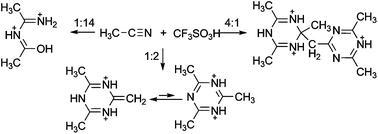Interaction of acetonitrile with trifluoromethanesulfonic acid: unexpected formation of a wide variety of structures†
Abstract
Interaction of

* Corresponding authors
a
Vorozhtsov Novosibirsk Institute of Organic Chemistry, Academician Lavrent'ev Ave., 9, Novosibirsk 630090, Russian Federation
E-mail:
genaev@nioch.nsc.ru
Fax: +7-383-330-97-52
Interaction of

 Please wait while we load your content...
Something went wrong. Try again?
Please wait while we load your content...
Something went wrong. Try again?
G. E. Salnikov, A. M. Genaev, V. G. Vasiliev and V. G. Shubin, Org. Biomol. Chem., 2012, 10, 2282 DOI: 10.1039/C2OB06841A
To request permission to reproduce material from this article, please go to the Copyright Clearance Center request page.
If you are an author contributing to an RSC publication, you do not need to request permission provided correct acknowledgement is given.
If you are the author of this article, you do not need to request permission to reproduce figures and diagrams provided correct acknowledgement is given. If you want to reproduce the whole article in a third-party publication (excluding your thesis/dissertation for which permission is not required) please go to the Copyright Clearance Center request page.
Read more about how to correctly acknowledge RSC content.
 Fetching data from CrossRef.
Fetching data from CrossRef.
This may take some time to load.
Loading related content
